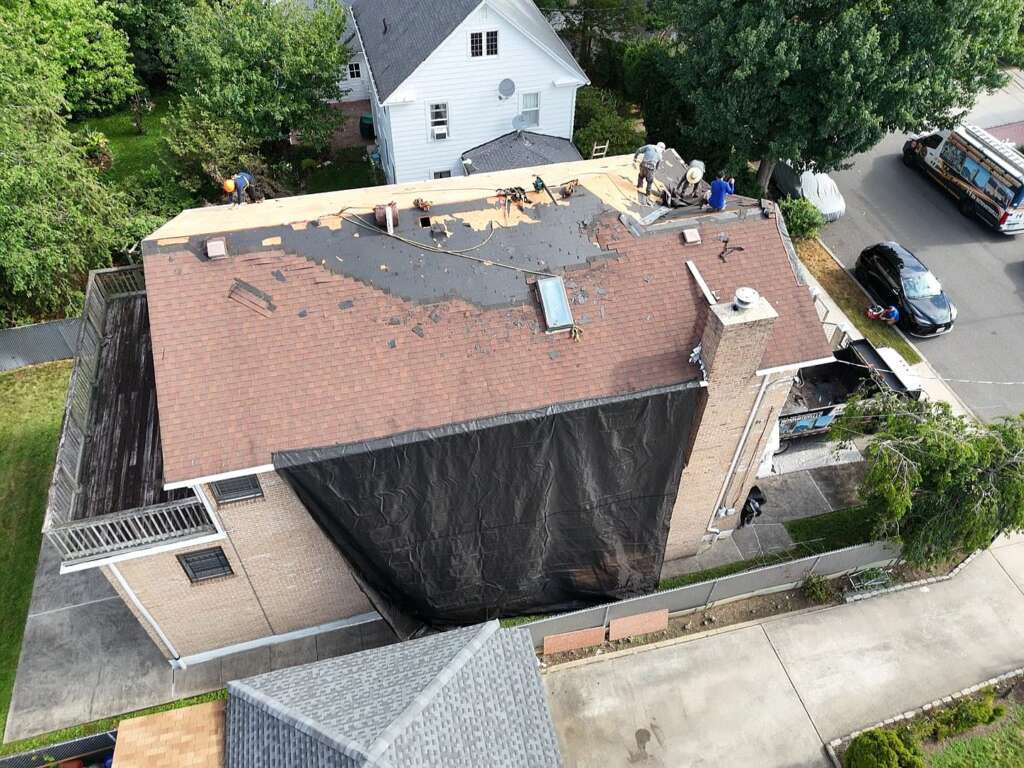You may think that if a storm only brings strong winds, but no hail or heavy rain, your roof is safe. Unfortunately, that’s not always the case. Strong winds can create pressure points around your roof, loosening shingles, damaging flashing, and even pulling apart sections of your roofing system. Over time, these minor issues can compromise the structure of your roof and lead to costly water damage.
Roofs are designed to withstand typical weather conditions, but when winds hit above 40–50 mph, as the National Weather Service notes, moderate property damage becomes likely. And once winds exceed 58 mph, you’re looking at potentially serious damage.
Understanding how to spot wind damage early is crucial. Addressing minor problems quickly will not only extend the life of your roof but also save you money on energy bills and costly structural repairs.
In this guide, we’ll walk you through how wind damages your roof, what signs to look for, and a 7-step checklist to help you spot wind damage effectively.
How Does Wind Damage Your Roof?
Wind doesn’t uniformly hit your roof. The perimeter, edges, and corners of a roof bear the brunt of the force, while the centre typically experiences less stress. When shingles, tiles, or other roofing materials are even slightly loose at the edges, wind can push underneath them and lift them. Each storm exacerbates the problem until the shingles are torn off completely.
Another primary concern is debris carried by the wind. Tree branches, nails, glass, stones, or other objects can crash into your roof, damaging shingles, puncturing materials, or denting flashing. These impacts are often more harmful than the wind itself.
The result? Missing shingles, water leaks, insulation exposure, and eventually mould or structural issues if left unchecked.
What Does Wind Damage Look Like on a Roof?
Wind damage doesn’t always show itself immediately. Initially, you may notice minor peeling, curling shingles, or granule loss. Over time, this expands and exposes insulation and underlayment, leading to leaks.
Extensive wind damage—where more than 30% of your roof is affected—often means a complete roof replacement is more cost-effective than repairs. Localised damage (under 30%) can usually be fixed with targeted repairs.
7 Steps to Spot Wind Damage on Your Roof
Here’s a practical, step-by-step guide to checking your roof for damage after high winds or storms.
1. Inspect Your Shingles
Shingles are the first line of defence for your roof. Look for:
- Missing or torn shingles
- Curling or cracked edges
- Granule loss (check for granules in gutters)
- Shingles lifted or overlapping unnaturally
For wood shingles, check for curling, splitting, or mould growth. Metal or slate shingles may exhibit dents, cracks, or missing sections due to impact from flying debris.
2. Check Roofing Cement
If your roof has been patched in the past, those areas may be vulnerable. Roofing cement is used to seal small holes, valleys, or flashing. After strong winds, look for:
- Cracks in the cement
- Crumbling edges
- Signs of water intrusion near cemented areas
Any compromise here can quickly lead to leaks.
3. Examine the Chimney
Chimneys often take a beating during storms. Wind damage here might look like:
- Missing or cracked bricks
- Loose or damaged flashing at the chimney base
- Crumbling mortar joints
- A leaning chimney structure
Mortar erosion or separation from the roofline needs urgent attention, as it leaves openings for water to seep in.
4. Inspect the Flashing
Flashing protects vulnerable joints on your roof. You’ll find it around chimneys, skylights, vents, and valleys. Signs of wind damage include:
- Buckling or bending
- Rust spots or corrosion
- Tears, dents, or separation from roofing materials
Damaged flashing often leads to hidden leaks, which can quietly deteriorate your roof deck and insulation if left unaddressed.
5. Look at Fascia and Soffits
The fascia (boards at roof edges) and soffits (undersides of roof overhangs) seal your roof’s edges. Since they are on the perimeter, they’re highly exposed to wind. Warning signs include:
- Cracked or peeling paint
- Water stains
- Warped, missing, or rotting sections
- Blocked soffit vents
Once fascia or soffits weaken, water can infiltrate your roof system and interior walls.
6. Inspect Gutters and Downspouts
Your gutters play a vital role in directing water away from your home. After strong winds, check for:
- Leaks at seams
- Rust spots or bending
- Detached or sagging sections
- Blockages from leaves or storm debris
Clogged or damaged gutters can overflow, allowing water to pool near your foundation or back up under your roofline.
7. Flat Roof Areas (if applicable)
Flat roofs are particularly vulnerable to wind damage. Signs include:
- Wrinkles, blisters, or cracks in the roofing membrane
- Torn or missing patches
- Ponding water after rainfall
- Damp spots are visible inside your attic or ceiling
Because flat roofs don’t shed water as easily as pitched roofs, routine inspection after windstorms is essential.
Do an Indoor Inspection
Once you’ve inspected the exterior, don’t forget the inside. Warning signs of roof damage inside your home include:
- Water stains on ceilings or walls (yellow, brown, or grey patches)
- Peeling or bubbling paint
- Damp spots in your attic or along rafters
- A sudden spike in energy bills can mean damaged insulation or ventilation issues
Indoor signs often indicate damage has already allowed water inside, so it’s critical to act quickly.
Contact RH Renovation LLC for Professional Roof Damage Repairs in Westchester
While you can spot many signs of wind damage on your own, repairing them is best left to professionals. Climbing onto your roof can be hazardous, and improper repairs can exacerbate the situation.
At RH Renovation LLC, we specialise in roofing repairs and replacements across New York City and Westchester. Whether you’ve lost shingles, need flashing replaced, or require a complete roof restoration after a storm, our team is certified, experienced, and equipped with modern techniques to restore your roof quickly and affordably.
We also offer comprehensive exterior services, including chimney repairs, gutter installation, skylight replacement, deck construction, and other related services. With our FREE estimates, you’ll know exactly what to expect before any work begins.
Final Thoughts
Wind damage may seem less severe than hail or heavy rain, but it can be just as destructive to your roof. By following this 7-step inspection guide—checking shingles, cement, chimneys, flashing, fascia, gutters, and flat roof areas—you’ll be able to catch early signs of trouble before they turn into costly repairs.
And remember: after every storm, take a moment to check inside your home for leaks or water stains.
If you suspect wind damage on your roof, don’t wait. Contact RH Renovation LLC today for a professional roof inspection and reliable repairs in Westchester and surrounding areas. Protect your home now before minor issues become major headaches.



